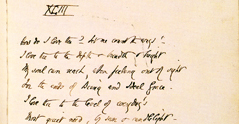CHURCH MISSIONARY SOCIETY ARCHIVE: SECTION VI: Missions to India Part 9
Part 9: Punjab and Sindh Mission, 1935-1959
In every way, the Punjab was one of Great Britain's most important assets in colonial India. Its political and geographic predominance gave Britain a base from which to project its power over more than 500 princely states that made up India. Lahore was a center of learning and culture under British rule, and Rawalpindi became an important Army installation.
In 1930, the Indian National Congress proclaimed independence from Lahore and the 1940 Lahore Resolution of the Muslim League to work for Pakistan, made Punjab the centre of a violent struggle.
In 1946, massive communal tensions and violence erupted between the majority Muslims of Punjab, and the Hindu and Sikh minorities. The Muslim League attacked the government of Unionist Punjabi Muslims, Sikh Akalis and the Congress, and led to its downfall. The Sikhs and Hindus counter-attacked and the resulting bloodshed left the province in great disorder. Both Congress and League leaders agreed to partition Punjab in 1947 upon religious lines, a precursor to the wider partition of the country.
In 1947, the Punjab Province of British India was divided along religious lines into West Punjab and East Punjab. The Muslim western part was assimilated into the new country of Pakistan while the eastern part consisting mostly of Sikhs and Hindus stayed in India. This led to rioting and both sides committed atrocities against fleeing refugees as many Sikhs and Hindus lived in the west, and many Muslims lived in the east. Millions of Muslims were uprooted from their homes and fled to the west and similarly Sikhs and Hindus fled to the east.
The province of Sindh regained its self rule on Indian Independence in 1947. The great challenge faced by the Government of Sindh was the settlement of Muslim refugees who settled mostly in urban areas, most of them in Karachi and Hyderabad.
The CMS papers for Punjab and Sindh for 1935-1959 cover all the main political events of these tumultuous years as well as natural disasters such as the Punjab floods, 1955 and the earthquake in Quetta in 1935. Also included is a wealth of detail on CMS mission administration, education and medical work.
Topics included are:
- Property transfer from CMS to the Lahore Diocesan Church
- Correspondence regarding the appointment of a Punjab Secretary after the death of Miss Olive Cocks
- The teaching of Islam to Moslems in schools
- A proposal to open up medical work in South Waziristan
- Report on medical work, including that carried out among women and minutes of meetings of the Medical Executive Committee, Lahore
- Report of a Special Committee to review the policy of work in the High Schools
- Report of the Home Secretaries’ visit to India, 1934-1935
- The training of ordinands
- History of the mission hospital at Amritsar
- CMS News Sheets regarding the North West Frontier of Pakistan (Peshawar) and hospitals in the medical missions
- Details of the Pakistani Military Nursing Service
- Work of Bible Women
- Consecration of the Bishop of Lahore
- Notes on the needs of the Archdeaconry of the East Punjab
- Reports on the Lahore diocese by Canon R W F Wootton
- Report on a tour to Thal and Tank and Dera Ismail Khan, April 1959 by Canon R W F Wootton
- Report on a conference on the occasion of the visit of the CMS Asian Group Secretary to West Pakistan, 1958
- Minutes of meetings of the Standing Committee of the Lahore Diocesan Council, 1957
- Correspondence regarding the floods in the Punjab by Florence Collier of CEZMS, October 1955
- Proceedings of the 11th session of the Lahore Diocesan Council December 1946
- Report by Dr H B T Holland on possible famine in West Pakistan and relief work
- Report on Muslim refugees and relief work by L H Woolmer
- Details of the Constitution of the Sindh Church and Mission Council and proceedings of the first general meeting, 1943
- Minutes of meetings of the Medical Executive Committee
- Minutes of meetings of the Educational Sub-Committee
- Minutes of meetings of the Executive Committee of the Church and Mission Central Council
- Minutes of meetings of the Women’s Medical Sub-Committee
- Minutes of meetings of the Standing Committee of the CMS and CEZMS Women’s Joint Conference
- Minutes of meetings of the Pastoral and Evangelistic Committee
- Minutes of meetings of the Men’s Educational Sub-Committee
- Minutes of meetings of the Frontier Church and Mission District Council
- Minutes of meetings of the Finance and Audit Committee
- Minutes of meetings of the Ordination and Clergy Committee
- Proceedings of the Lahore Diocesan Council
- Minutes of a meeting of the Clarkabad Board of Management
- Minutes of meetings of the Diocesan Board of Women’s Work
- Report on the Women’s Conference at Nagpur, 1959
- Reports on schools including Alexandra Girls’ High School, Amritsar; Pennell High School, Bannu; Baring Union Christian College, Batala; Henry Martyn School of Islamics, Lahore; Kinnaird College for Women, Lahore; Narowal Boys’ School; Edwardes College, Peshawar; Girls’ School and the Tyndale Biscoe Memorial High School, Srinagar
- Sale of CMS property
- Descriptions of the aftermath of partition after Independence, 1947
- Details on famine relief and land settlement
- Reports on medical missions and hospitals at Anantnag, Bannu, Clarkabad, Dera Ismail Khan, Ludhiana, Montgomerywala, Multan, Peshawar
- Reports on the earthquake at Quetta, 1935 and the destruction of the hospital and meetings of the Quetta Hospital Plans Sub-Committee regarding the reconstruction of the building
|















